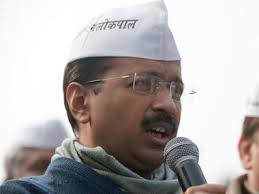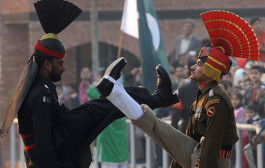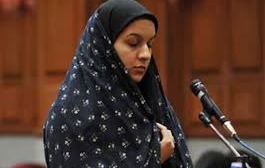The only prediction that can be made with certainty about the Delhi Assembly Election scheduled for 7 February is that it will be unpredictable till the end. The reason, of course, is Arvind Kejriwal. The other prediction one is happy to make is this: defeat is not going to wipe out either the Aam Aadmi Party (AAP) or even the BJP. Both parties have it in them to revive themselves after a defeat for they are driven by emotional appeal, and not just normal politics.
But the central focus of this article is Kejriwal. He is the man who makes this election interesting, not Kiran Bedi or Narendra Modi or Ajay Maken. So it is worth expending a few minutes to decode the politics and appeal of Kejriwal, and how it has the potential to break the mould of Indian politics. However, he also has the potential to self-destruct, as he almost did last year with his 49-day tenure.
MUST READ: 2015 Delhi Assembly elections: Full coverage
The big test in this election thus is not between AAP and BJP, or even between Kejriwal and Bedi/Modi, but between the Idea of Kejriwal and the Idea of AAP. The paradox of this election is that the Idea of AAP has taken second-place to the projection of the Idea of Kejriwal – as is evident from AAP’s slogan (Paanch Saal Kejriwal). This is no different from the Idea of Modi in 2014.
So let’s examine why Kejriwal is trumping AAP. He is the hero, AAP the cipher. AAP is now defined by who he is, and what he stands for, as against the original Idea of AAP (anti-corruption, non-personality-based politics, ground-up empowerment, etc). Not all of the original AAP is gone, but we will know only if Kejriwal wins this time.
Here is what is different about Kejriwal’s politics, and what is the same old politics clothed in new rhetoric.
What’s new: The main differentiator for Kejriwal’s version of AAP is that it talks the language of participatory politics. Unlike other parties (barring the BJP and the Left) its grassroots connect comes from middle class activism, driven by idealism and voluntarism. You cannot stop a force that is propelled by genuine believers in the Idea of AAP, even though it is the Kejriwal persona that now dominates it. AAP is driven by hopes of change.
What’s not new: Kejriwal does not have a coherent ideology beyond the traditional freebie culture of the Congress, the regional parties or the Left. This is why in his 49-day government, Kejriwal pushed his free water and electricity tariff cuts without even attempting to understand the economics of his gesture. If Kejriwal makes freebies his mantra, he will end up exactly where the Congress is today.
What’s new: Kejriwal has consciously sought to distance himself from the red beacon culture and opulent security. He has tried to move directly among the people and thus eliminated the physical and emotional distance between leaders and the led. He has set the agenda in this area, and other parties are forced to take note.
What’s not new: Despite a veneer of humility and an attitude of listening to the people, Kejriwal actually believes he is a man of destiny. A personality cult has developed around him, and he seems to like it. While going through the motions of seeking people’s opinions on leading the government in December 2013, he did no such consultation when it came to quitting in February after just 49 days. Clearly, like all leaders, he knows that every decision cannot be taken by popular vote. Leaders have to take some calls on their own.
What’s not new: Intemperate attacks are not new in Indian politics. There is almost no party which has not attacked rival politicians or targeted businessmen in some way or the other. The late YS Rajasekhara Reddy targeted media that was close to Chandrababu Naidu, and also businessmen connected to those media. J Jayalalithaa targeted the Sun TV group, and the Marans’ businesses. The danger in this kind of targeting and mud-slinging is that it can permanently alienate business in general, making the prospect of genuine entrepreneurship without cronyism difficult. Kejriwal’s attacks will force businessmen to think they need political protection, not the other way round.
What’s new: Kejriwal has redefined street politics with doses of smart tactics and strategy. He has tried to use street power to attack the system. In his 49 days as CM, he exhorted ordinary people to do stings to check the corrupt, and, in one memorable midnight caper, his law minister tried to get the police to check alleged prostitution involving African women. That raid ended in ignominy, but the fact remains that Somnath Bharati tried to get the police to respond to the concerns of the community they were meant to be responsive to.
What’s not new: There is no Indian party that does not practice street politics. All real political issues are often settled on the street, and finally find expression through the ballot box. Mamata Banerjee did so over the land acquisition issue and tossed the Left out of power. The Shiv Sena routinely takes to the streets on Marathi manoos issues, and the BJP on real and imagined slights to Hindus. The “secular” parties regularly encourage the minorities to protest on the streets to seal this vote bank. The problem for Kejriwal is that street politics ultimately leads to kangaroo courts and vigilantism – as Somnath Bharti found out to his cost. It is easy to agitate mobs, tough to rein them in.
What’s new: Kejriwal has by and large brought forth real issues, and largely eschewed sectarian politics. This is one reason why Muslims are looking at AAP as a potential alternative to failed “secular” parties.
What’s not new: In the last election Kejriwal did dabble with minority politics by schmoozing with dubious clerics, but he did not carry it too far. But AAP is untested beyond Delhi, which is largely urbanised and hence less vulnerable to excessive sectarian appeal. Moreover, sectarian issues of caste and religion will not go away when his party tries to expand. One cannot be sure that Kejriwal will completely break away from the old politics of division practiced by all parties.
What’s new: Kejriwal has galvanised the middle classes, something that most political parties (barring the BJP) have ignored in the past. Through his 49 days in power, he has probably split the middle class by retaining the lower end of this class and losing the upper end by focusing on protests instead of governance.
What’s not new: Like every other party, Kejriwal has indeed accepted the need for divide and rule. This has been done by dividing his support base on the basis of class. He has also tried to split business by appearing to be on the side of small business, and being avowedly anti-crony business. But even in big business, he has targeted some and spared the rest. This has to be deliberate, for the truth is few Indian businesses have clean hands. He must have thought that taking on everybody would leave him without resources and friends.
Here’s the bottomline: Like May 2014, which was about Modi, February 2015 is about Kejriwal. Whoever wins, this is the real issue that will be tested.








